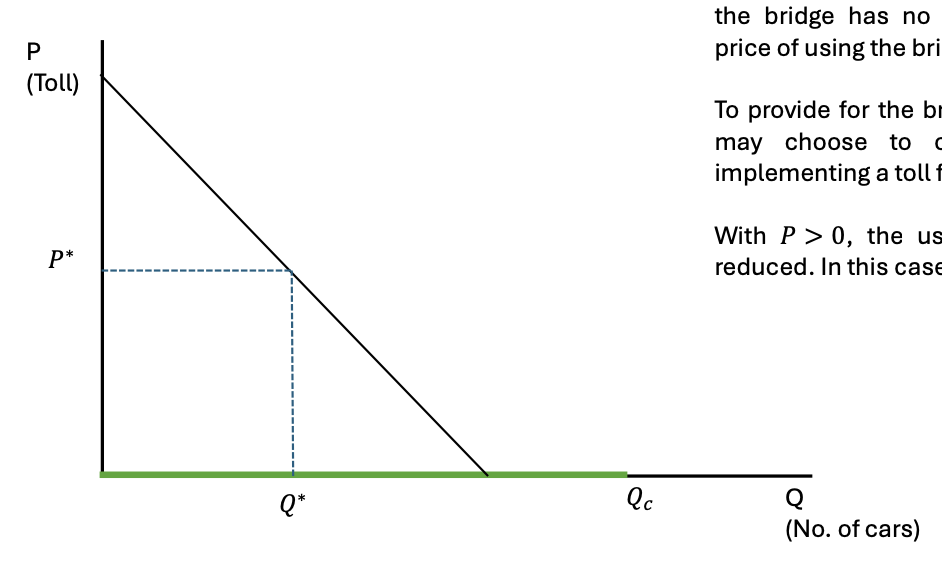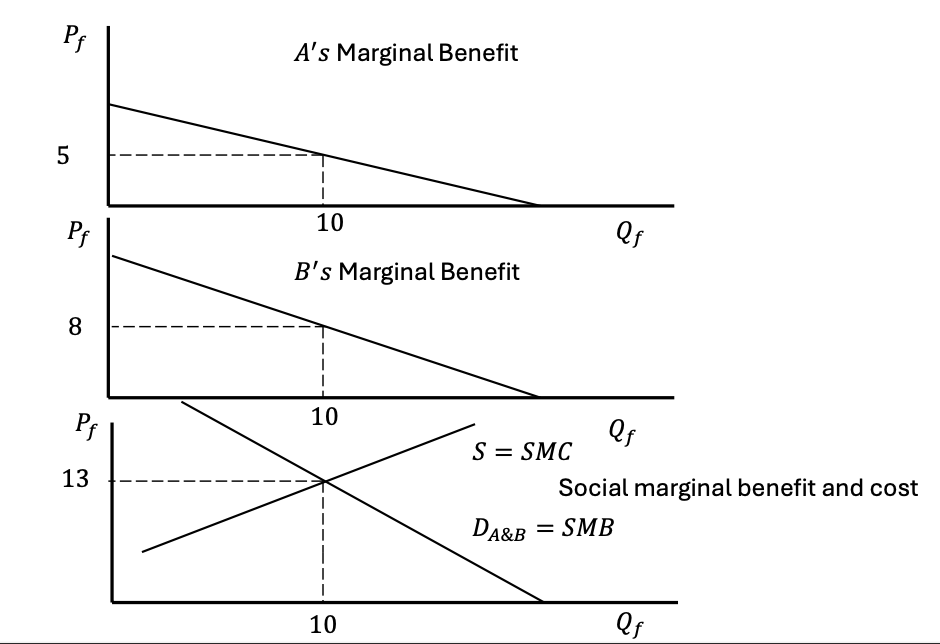Public Goods
1/15
Earn XP
Description and Tags
Name | Mastery | Learn | Test | Matching | Spaced |
|---|
No study sessions yet.
16 Terms

explain non rival and non excludable
non-rival — something everyone can consume
non-excludable — everyone is able to consume the goods
explain club goods and give an example
club goods are goods that individuals can be prevented from consuming but are available to others
ex. tolled roads
explain common resources and give an example
common reosuces are goods anyone can use but are limited
ex. fresh water, fish, ect.
what are the 2 forms of inefficiencies
under consumption
under supply

what is this graph and what is it telling us
under consumption graph — tells us that when price is set to 0 (green line) everyone consumes the bridge, but the bridge needs to be paid for, hence the governement chooses to add a toll which limits the people who can use it
(in a sense your not maximizing the capacity as the number of people who use it decreased)
explain the inefficiency of undersupply
free rider probelm — people assume that others would contribute more leading to them either contributing less or none at all as they would benefit eitherway ( no one has incentive to contribute)
what is a numeraire good
good that is used as the benchmark to measure prices (usually =1)
when can we say that a private good is optimally provisioned

explain the optimality condition of private goods
since MRS is defined as the rate at which one is willing to give up one good for another, we can say that private goods are optimally provisioned if each individuals MRS (ratio of MU) equals the price ratio
this works as it tells us that for every price level, the individuals are willing to consume x amount of each good—therefore MRS = P
On the supply side P = MC as it shows the equilibria where firms are willing to provide
— MRS = MC as it gives both the price consumers are willing to pay and the supply firms are willing to produce

breifly explain how to get the market supply and demand
add the qty demanded for A and B, then see at which price their equilibrium qty meets price
explain the optimal condition for public goods
since everyone benefits simultaneously, we have to add up the valuation of all individuals WTP
its equal to MC as it guarantees the right amount of production


explain the graph
vertical summation as the quantity would become consumed by everyone, prices are added because its the total benefit to society
explain the difference of provisions for private vs public goods
Private — people only consider thier own benefits
Public — adding together all individuals WTP allows for the chance to purchase the societial optimal qty which would benefit everyone (parang nag pondohan)
can private provision overcome free rider problem
while it may aid, its not enough to reach socially optimal level
Factors that encourage private provision:
differences in demand for public goods — some value it more than others are may be willing to fund it
altruism — people genuinely care and are willing to contribute out of generosity
utility from ones own contribution (warm glow) — personal satisfaction from helping
public provision of public goods
gov can help but it comes with inefficiencies:
crowding-out effect — gov providing may redue private sectors contribution as theyd feel less inclined to give
difficulty inmeasuring cost and benefits — as everyone can consume the good, everyone benefits regardless of hm they pay, it becomes hard to measure everyones WTP
difficulty in determining public preferences — since its “free” people may not reveal thier true demand (like building a park, how much would people actually use it?)
full vs partial crowd out
full — when the amount priv sector reduces is the same amount gov provided
partial — when the amount priv sector reduces is less than the amount gov provided